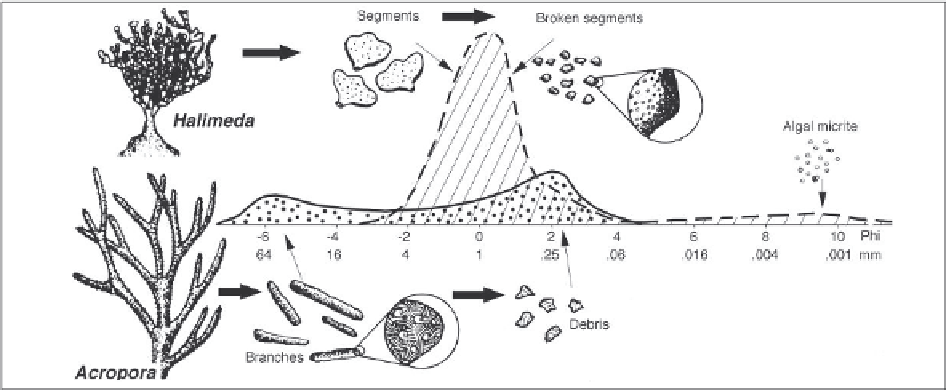Geology Reference
In-Depth Information
Fig. 6.4.
Disintegration of different calcareous organisms
results in different grain size fractions. In this example, the degree
of disintegration depends on the growth form and microstructure of the skeletons. Other case studies indicate significant
controls by hydrodynamic conditions. Calcareous green algae (
Halimeda
) disintegrate into millimeter- to micron-sized par-
ticles (see Fig. 4.3), corals (
Acropora
) into fine sand- and gravel-sized particles. In high-energy environments, the branching
colonies of the corals break into well-sorted sticks (average diameter about 4.5 mm); on abrasion, the sticks break further
down into well-sorted grains forming coral debris (0.25 mm). There is little coral material of intermediate size.
Halimeda
first falls apart into thin leaflike segments and further breaks into pieces averaging about 1 mm. During abrasion segments
eventually disintegrate into micron-sized aragonite crystals contributing to the formation of carbonate mud (< 0.004 mm).
Note that the example does not demonstrate the quantitative importance of algal micrite in low-energy lagoonal sediments.The
graphic is based on sieve analyses of high energy beach sediments of Isla Perez, Alacran reef complex (Yucatan). Modified
from Folk and Robles (1964).
•
major storm events, e.g. hurricanes and cyclones,
can completely change long-term grain-size distribu-
tion patterns in reefs and on platforms within hours.
different depositional settings (open-marine platform
edges, open and protected lagoons, platform reefs, to-
pographically differentiated shallow bays, subaerial and
submerged coastal areas).
Grain-size patterns of modern carbonates
Bioclastic carbonate sands
: Most grain-size stud-
ies of recent carbonates concern sand-sized sediments
deposited near the beach, in shallow inter- and subtidal
environments, and in reef complexes (Box 6.1). Stud-
ies of modern depositional environments reveal some
general patterns with respect to the size distribution of
carbonate grains in coastal and shallow-marine envi-
ronments and allow their major controls to be discussed.
These patterns were first recognized by Ginsburg
(1956) in Florida and later confirmed by statistically
based analyses of Caribbean reefs and platforms
(Alacran reef, Mexico: Folk 1962, 1967; Folk and Rob-
les 1964; Belize: Gischler 1994; St.Croix: Hubbard et
al. 1981), the Australian Great Barrier Reef (Flood and
Orme 1977), land-locked environments (Piller and
Mansour 1990) and reefs in the Red Sea, and in the
near-coast environments of the Persian Gulf and the
Gulf of Oman (Sarnthein 1971). Study areas have dif-
ferent scales: small - up to about one kilometer: Alacran
reef and St.Croix; medium - several kilometers: Bel-
ize and Red Sea; large - more than hundreds of kilo-
meters: Great Barrier Reef, Persian Gulf and include
The gross composition of the sediments is similar
and is characterized by the dominance of bioclastic
sands composed predominantly of variously disinte-
grated calcareous algae, corals, mollusks and foramin-
ifera. In addition, fecal pellets and intraclasts are of
some importance.
Occurrence of coarse-, medium- and fine-grained cal-
careous sands in shallow-marine environments
(1) Coarse- and very coarse-grained calcareous
sands (0.5 to 2 mm): Coarse bioclastic sediments com-
posed predominantly of calcareous algae, corals or fora-
minifera occur in different shallow-water settings in-
cluding outer windward reef rims and forereef areas,
reef flats, situated near patch reefs in inner platform
and lagoonal settings, at the boundaries of inner plat-
form basins and beaches. Some of these sands are lag
deposits (reef rims). Many but not all coarse-sized sands
occur in high-energy environments.
(2) Medium to fine-grained sands (0.25 to 0.12 mm):
Common in areas affected by tidal currents or in sub-
tidal areas of changing hydrodynamic conditions.

